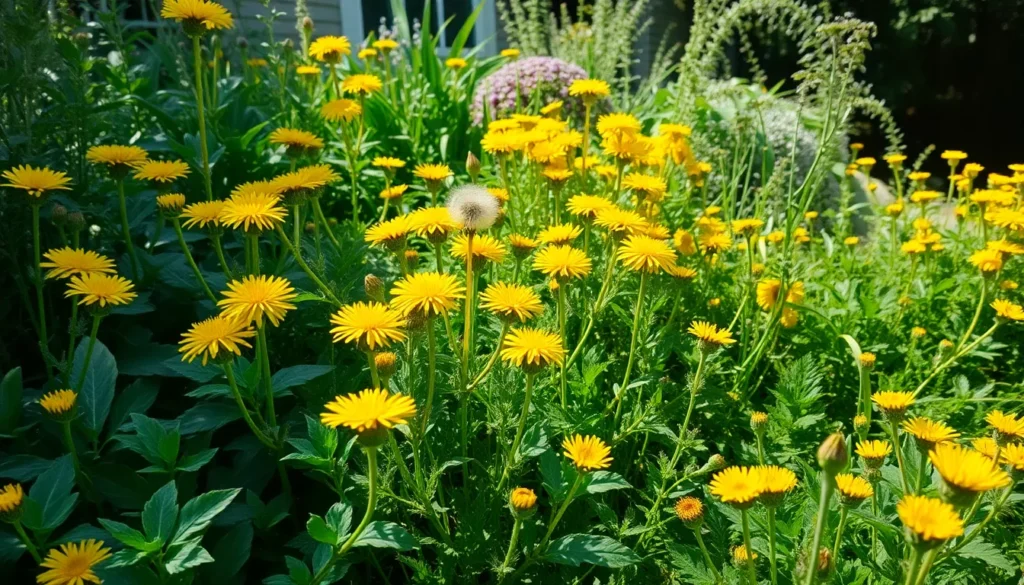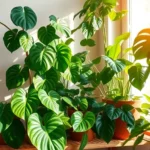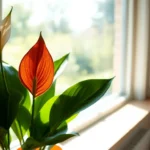Yellow flowers blooming in our gardens might look beautiful at first peek but they’re often unwanted guests that can quickly take over our carefully maintained landscapes. These bright golden invaders aren’t just random plants – they’re persistent weeds that have mastered the art of survival and reproduction.
We’ve all spotted these cheerful yellow blooms popping up in our lawns sidewalks and flower beds. While they might add a splash of color to our outdoor spaces they’re actually competing with our desired plants for nutrients water and sunlight. Understanding which yellow-flowered weeds we’re dealing with is crucial for effective control and prevention.
From the notorious dandelion to the stubborn wild mustard these common weeds share similar characteristics that make them particularly challenging to eliminate. We’ll explore the most common yellow-flowered weeds you’re likely to encounter and provide you with the knowledge needed to identify and manage them effectively before they turn your pristine garden into their permanent home.
Understanding Common Weeds With Yellow Flowers
Yellow flowered weeds appear across diverse landscapes due to exact biological and environmental factors. These resilient plants demonstrate remarkable adaptability that allows them to thrive in various conditions where cultivated plants struggle.
Why Yellow-Flowered Weeds Are So Prevalent
Evolutionary advantages make yellow flowered weeds exceptionally successful colonizers in disturbed soils and neglected areas. Yellow blooms attract pollinators like bees, butterflies, and hoverflies more effectively than many other flower colors, particularly during early spring when fewer competing flowers exist.
Reproductive efficiency drives their widespread distribution through multiple mechanisms:
- Rapid seed production enables single plants to generate 2,000 to 15,000 seeds annually
- Wind dispersal systems carry lightweight seeds across distances of 100 miles or more
- Vegetative propagation through runners, rhizomes, and root fragments creates new colonies
- Drought tolerance allows survival in conditions that stress desirable garden plants
Resource competition gives these weeds important advantages over cultivated species. Deep taproot systems extend 6 to 10 feet underground, accessing water and nutrients beyond the reach of shallow rooted crops and ornamentals. Dense growth patterns shade out competing vegetation while aggressive root systems deplete soil resources.
Soil adaptability enables yellow flowered weeds to establish in conditions ranging from acidic pH 4.5 to alkaline pH 8.5. Compacted soils, poor drainage, and low fertility conditions favor their growth over more demanding industry plants.
Seasonal Patterns of Yellow-Flowered Weeds
Spring emergence marks the beginning of peak yellow flowered weed activity as soil temperatures reach 45°F to 50°F. Cool season species like wild mustard and field pennycress germinate in March and April, taking advantage of spring moisture and reduced competition from warm season plants.
Early bloomers dominate the industry during exact timeframes:
| Weed Species | Peak Bloom Period | Duration |
|---|---|---|
| Dandelion | April – May | 6-8 weeks |
| Wild Mustard | May – June | 4-6 weeks |
| Buttercup | April – July | 12-16 weeks |
| Black Medic | June – September | 16-20 weeks |
Summer continuation sees warm season yellow flowered weeds taking over as spring species decline. Crabgrass, purslane, and spurge family members produce continuous blooms from July through September, maintaining constant seed production throughout the growing season.
Fall resurgence brings a second wave of activity as temperatures moderate and autumn rains stimulate new growth. Perennial species like goldenrod and Jerusalem artichoke develop extensive root systems during this period, storing energy for aggressive spring emergence.
Winter survival strategies vary among species but ensure population continuity. Annual weeds survive as dormant seeds in soil seed banks containing 10,000 to 50,000 viable seeds per square foot. Perennial weeds maintain living root systems that remain active even under snow cover, ready to produce new shoots when conditions improve.
Tools and Materials for Weed Identification and Control
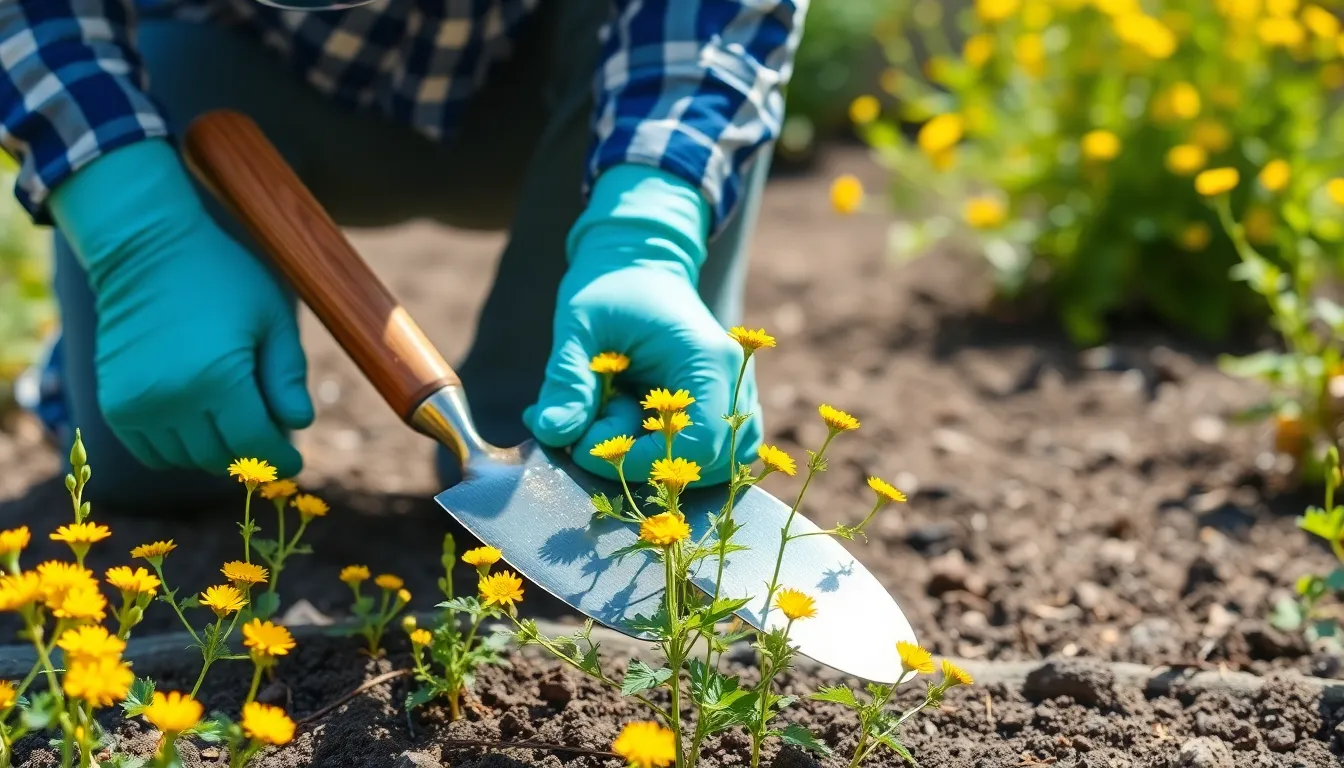
Successful identification and control of yellow flowered weeds requires exact tools and protective equipment. Proper equipment selection makes the difference between effective management and wasted effort.
Essential Identification Tools
Hand lenses and magnifying glasses enable detailed examination of small plant parts like flower structures and leaf margins. These tools reveal distinguishing characteristics that separate dandelions from buttercups or wild mustard species.
Field guides and online resources provide comprehensive comparison databases for accurate species identification. Apps like PlantSnap and iNaturalist offer instant photograph matching with extensive weed databases containing thousands of yellow flowered species.
Dichotomous and interactive keys streamline the identification process by presenting systematic choice pathways based on observable plant characteristics. These resources eliminate guesswork when distinguishing between similar looking species like various Ranunculus varieties.
Spectral analyzers such as the Trimble GreenSeeker deliver advanced identification capabilities through spectral signature analysis. Professional landscapers use these devices to identify weeds across large areas with 95% accuracy rates.
Removal Equipment and Supplies
Hand weeding tools form the foundation of mechanical weed control operations. Gloves protect hands during extended weeding sessions while trowels provide leverage for removing established root systems.
Weed pullers extract deep rooted perennials like dandelions without breaking the taproot system. These specialized tools reduce regrowth rates by 80% compared to surface cutting methods.
Herbicides address widespread infestations where manual removal becomes impractical. Selective herbicides target broadleaf weeds while preserving desirable grass species in lawn applications.
Safety Gear and Protective Equipment
Gloves prevent skin irritation from plant sap and chemical contact during herbicide applications. Nitrile gloves offer superior chemical resistance compared to standard gardening gloves.
Eye protection shields against chemical splashes and flying debris during mechanical removal operations. Safety glasses become essential when using power tools or applying liquid herbicides.
Long sleeved clothing creates a barrier against allergens and skin irritants present in many yellow flowered weed species. Buttercup plants contain compounds that cause contact dermatitis in sensitive individuals.
How to Identify Yellow-Flowered Weeds in Your Yard
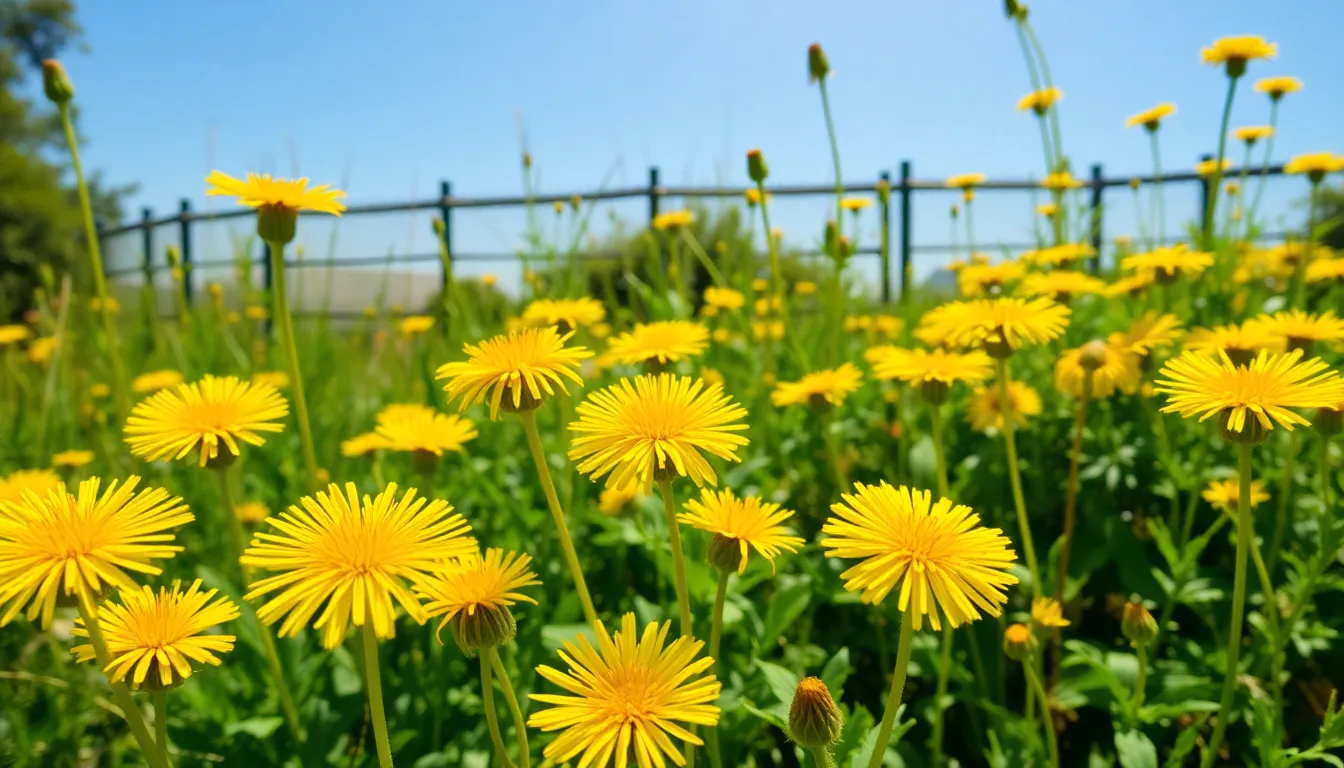
Accurate identification forms the foundation of effective weed management in our gardens. Distinguishing between different yellow-flowered species requires systematic observation of exact plant characteristics.
Key Physical Characteristics to Look For
Dandelion-like flower structures appear frequently among yellow-flowered weeds, particularly in species from the Buttercup family such as Creeping Buttercup (Ranunculus repens). These flowers typically display multiple bright yellow petals arranged in circular patterns around central reproductive parts.
Leaf shapes provide critical identification markers for separating similar species. Comfrey (Symphytum grandiflorum) exhibits large flat leaves that resemble hoof shapes, creating distinctive foliage patterns that contrast sharply with other yellow-flowered weeds.
Flower clustering patterns distinguish many species from solitary bloomers. Yellow Trefoil (Trifolium dubium) produces small clustered arrangements of tiny yellow flowers, while Rocket (Erucastrum) displays similar clustering behaviors in compact formations.
Growth habits and stem structures offer additional identification criteria. Examine whether plants grow as low rosettes, upright stalks, or spreading mats across the ground surface.
Using Plant Identification Apps and Resources
Digital identification tools streamline the recognition process through advanced image recognition technology. PlantSnap and Leafsnap apps analyze uploaded photos of plant leaves and flowers to provide species matches with high accuracy rates.
Comprehensive online databases expand our identification capabilities beyond mobile applications. Lawnscience and Epic Gardening websites maintain detailed photographic guides featuring common yellow-flowered weeds with accompanying descriptions of distinguishing characteristics.
Regional gardening communities contribute valuable local expertise through specialized forums and discussion groups. Experienced gardeners share insights about exact yellow-flowered weeds prevalent in particular geographic areas, climate zones, and soil conditions.
Professional extension services offer authoritative identification resources through university agricultural programs and county extension offices.
Taking Photos for Accurate Identification
Clear lighting conditions enhance photo quality for reliable species identification. Capture images during daylight hours with even illumination that reveals flower details, leaf textures, and stem characteristics without harsh shadows or overexposure.
Multiple perspective angles document complete plant structures from various viewpoints. Photograph flowers from above and side angles, capture entire leaf arrangements, and document overall growth patterns to provide comprehensive visual information.
Close-up detail shots reveal distinguishing features that separate similar species. Focus on flower centers, leaf edge patterns, stem textures, and any unique markings that characterize exact yellow-flowered weeds.
Comparative reference materials support accurate identification through systematic photo comparisons. Match captured images against established plant identification guides, botanical databases, and verified species photographs to confirm initial identifications.
Most Common Weeds With Yellow Flowers
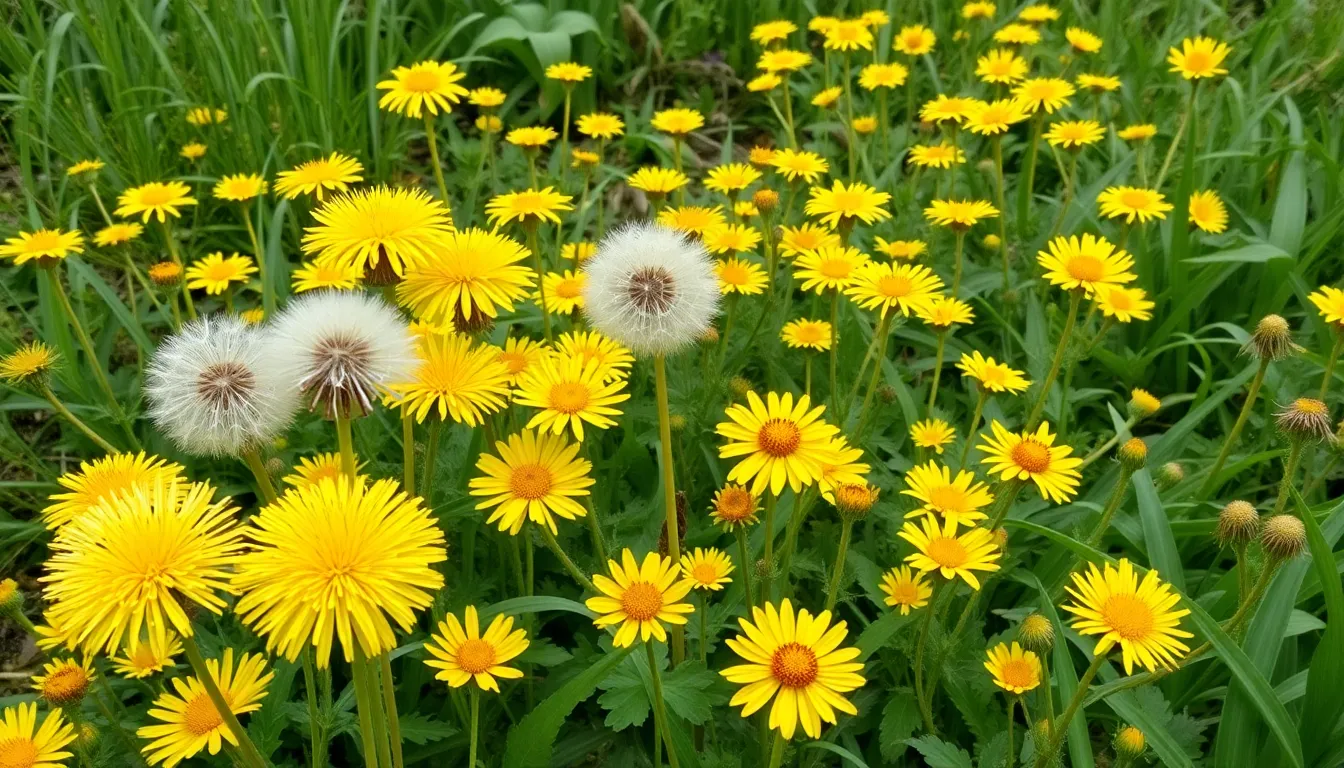
Five yellow-flowered weeds dominate our gardens and lawns across most regions. Dandelions, buttercups, wild mustard, crabgrass, and plantain represent the species we encounter most frequently during routine garden maintenance.
Dandelions: The Classic Yellow Weed
Dandelions (Taraxacum officinale) produce bright yellow flowers that transform into distinctive feathery plumes after blooming. These perennial weeds flower from May to August and establish themselves in virtually every lawn and garden setting we maintain.
Applying herbicides before the flowering stage proves more effective than treating established blooms. Deep taproot systems allow dandelions to access nutrients below surface level competition from grass and other plants. Single plants can produce up to 5,000 seeds annually through their signature white puff ball dispersal mechanism.
Buttercups: Bright and Persistent
Creeping Buttercup (Ranunculus repens) displays yellow flowers with 5 distinct petals that create glossy, cup-shaped blooms. Wet and heavy soil conditions provide the ideal environment for buttercup establishment and rapid spread.
Runner systems and seed production enable buttercups to colonize large areas within a single growing season. Shallow root networks spread horizontally rather than vertically, allowing these weeds to compete effectively with grass root systems. Dense mat formation crowds out desirable vegetation through aggressive ground coverage.
Wild Mustard: Fast-Growing Garden Invader
Wild Mustard (Brassica kaber) produces small yellow flowers arranged in terminal clusters that appear throughout the growing season. Fast growth rates and competitive seeding patterns make this annual weed particularly problematic in vegetable gardens and flower beds.
Garden invasion occurs rapidly due to wild mustard’s ability to germinate in cool soil temperatures before most cultivated plants begin active growth. Multiple generations per season increase population density and extend the control period required for effective management. Seed dispersal through wind and water carries wild mustard to new locations beyond the original infestation site.
Crabgrass: The Lawn’s Worst Enemy
Crabgrass (Digitaria spp.) produces yellowish to greenish flower spikes that extend above the grass canopy during summer months. This annual grass weed establishes itself in thin or damaged lawn areas where competition from desirable turf grass remains minimal.
Low-growing, spreading growth habits allow crabgrass to form dense mats that smother existing grass. Warm season germination patterns give crabgrass advantages over cool season lawn types during peak summer stress periods. Single plants can produce over 700 tillers and thousands of seeds before the first frost eliminates the current generation.
Plantain: The Broadleaf Challenge
Plantain (Plantago lanceolata) develops yellowish-green flower spikes on tall, narrow stems that rise above the basal leaf rosette. Broadleaf structure and persistent perennial root systems make plantain removal particularly challenging in both lawn and garden settings.
Dense rosette formation creates competitive pressure against surrounding vegetation through resource monopolization and light blocking. Fibrous root systems penetrate deeply into soil layers, allowing plantain to survive drought conditions that stress other plants. Seed production continues throughout the growing season, with mature plants capable of producing over 14,000 seeds annually.
How to Remove Yellow-Flowered Weeds Naturally
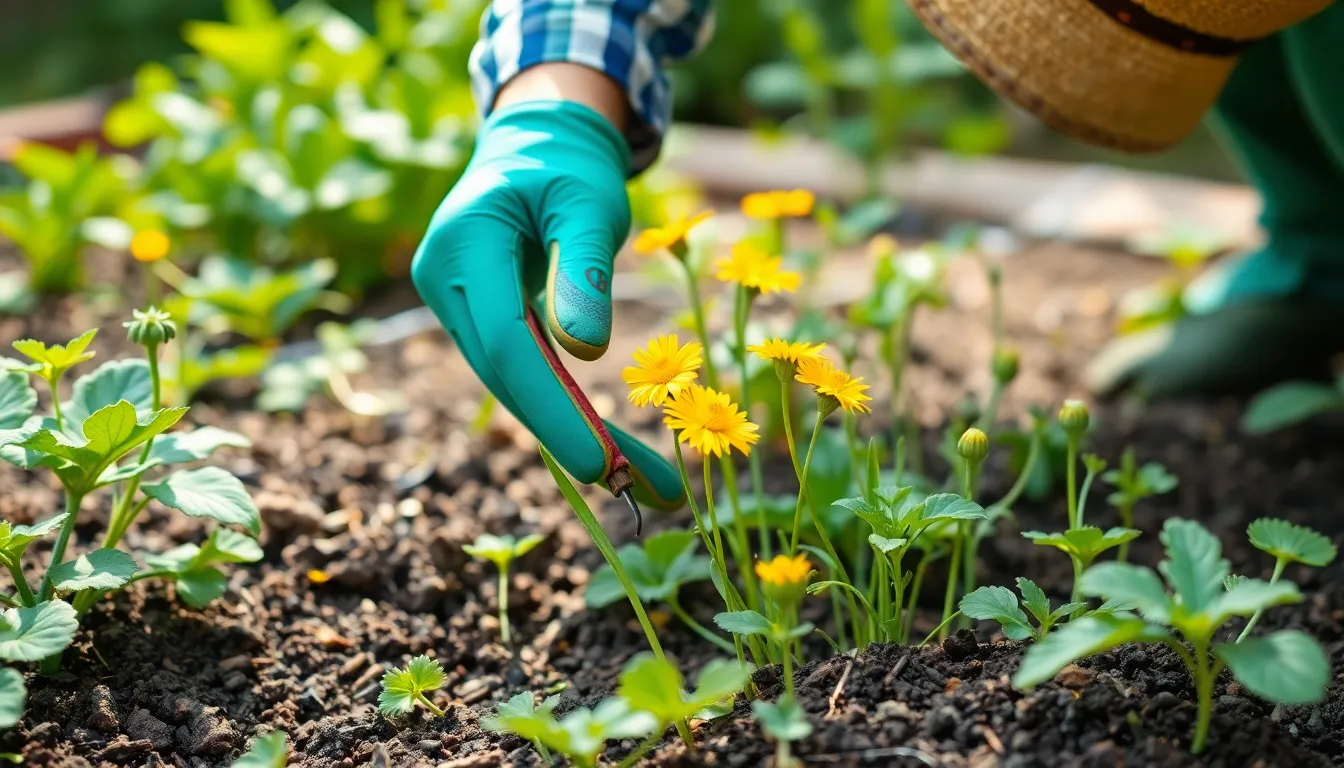
Natural removal methods eliminate yellow flowered weeds without synthetic chemicals while protecting surrounding plants and soil health.
Hand-Pulling Techniques for Different Root Systems
Fibrous root systems require gentle upward pressure to extract the entire network from soil. Weeds like henbit and black medic respond well to hand pulling since their shallow roots release easily from moist ground. Target these weeds after rainfall or watering when soil softens and roots loosen their grip.
Deep taproot systems demand specialized extraction techniques to prevent regrowth from remaining root fragments. Dandelions and plantain establish roots extending 6 to 10 inches deep that regenerate from small pieces left in soil. Use a dandelion weeder or long handled tool to penetrate alongside the taproot before applying steady upward force.
Timing extraction efforts during spring emergence maximizes success rates for all root types. Yellow flowered weeds concentrate energy in above ground growth during this period instead of strengthening root systems. Extract weeds when leaves appear but before flowers open to prevent seed production and dispersal.
Natural Herbicide Answers
Vinegar based answers containing 20% acetic acid concentration burn yellow flowered weed foliage on contact. Commercial horticultural vinegar proves more effective than household varieties with 5% acetic acid content. Apply vinegar treatments on sunny days when temperatures exceed 70°F to accelerate leaf desiccation.
Boiling water applications destroy cellular structure in yellow flowered weed tissues through thermal shock. Pour boiling water directly onto weed crowns and root zones to penetrate soil and damage underground growth points. Repeat treatments every 7 to 10 days for 3 applications to exhaust root energy reserves completely.
Corn gluten meal functions as a pre emergent natural herbicide that prevents yellow flowered weed seeds from germinating successfully. Apply 20 pounds of corn gluten meal per 1,000 square feet in early spring before soil temperatures reach 50°F. Time applications 4 to 6 weeks before expected germination periods for maximum prevention effectiveness.
Mulching to Prevent Regrowth
Organic mulch layers measuring 3 to 4 inches thick block sunlight penetration and suppress yellow flowered weed emergence. Wood chips, shredded leaves, and straw create effective barriers that decompose gradually while enriching soil structure. Maintain mulch depth throughout growing seasons since settling and decomposition reduce protective coverage over time.
Cardboard barriers placed beneath organic mulch eliminate established yellow flowered weeds through light exclusion and root suppression. Overlap cardboard edges by 6 inches to prevent gaps where weeds might penetrate protective layers. Wet cardboard thoroughly before adding mulch to accelerate decomposition and improve soil contact.
Strategic mulch placement around desired plants creates weed free zones while conserving soil moisture and moderating temperature fluctuations. Pull mulch 2 inches away from plant stems to prevent moisture retention issues and pest harborage problems. Replenish mulch annually in spring to maintain 3 inch minimum thickness for optimal weed suppression performance.
Chemical Control Methods for Stubborn Yellow Weeds
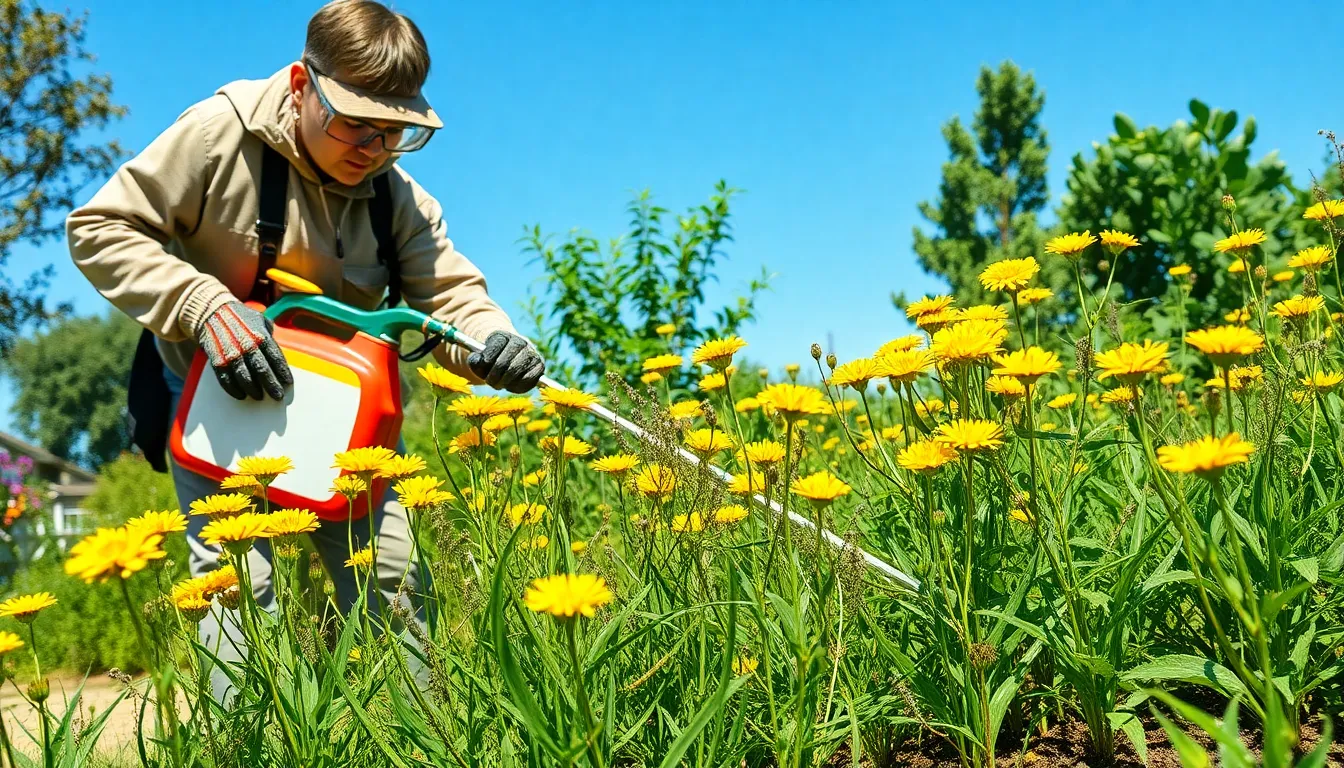
Persistent yellow flowered weeds require chemical intervention when natural methods prove insufficient. Chemical herbicides provide effective control for established populations that resist hand pulling and natural treatments.
Selecting the Right Herbicide
Pre emergent herbicides prevent yellow weeds like woodsorrel from germinating before they establish root systems. Apply these products before weed emergence occurs, timing applications based on exact lifecycle knowledge for target species.
Post emergent herbicides target existing yellow flowered weeds during active growth phases. Glyphosate demonstrates effectiveness during flowering stages of species like yellow flag iris. 2,4-D amine provides selective control for broadleaf yellow weeds without damaging grass. Triclopyr offers enhanced performance on woody stemmed yellow flowering plants.
Choose herbicide formulations based on weed species characteristics and surrounding vegetation sensitivity. Selective herbicides protect desirable plants while targeting exact weed types. Non selective options eliminate all vegetation in treated areas.
Application Timing and Techniques
Apply herbicides during active growth stages for maximum absorption and translocation. Target yellow starthistle before flowering begins to achieve optimal control rates. Rosette and pre flowering stages offer prime application windows for most yellow flowered species.
Spray treatments when soil moisture levels support active plant metabolism. Moist soil conditions enhance herbicide uptake through root systems. Active growth periods increase chemical movement throughout plant tissues.
Apply herbicides during calm weather conditions to prevent drift onto desirable plants. Direct spray patterns precisely to target weed foliage while avoiding contact with ornamental species. Use low pressure settings and appropriate nozzle types to minimize overspray.
Safety Precautions When Using Chemicals
Wear protective clothing including gloves and eyewear to prevent skin and eye exposure during application. Chemical resistant materials provide essential barriers against herbicide contact.
Prevent herbicide contact with desirable plants and water sources through careful application practices. Shield nearby vegetation using cardboard barriers or targeted application equipment. Maintain buffer zones around wells, streams, and drainage areas.
Avoid spraying when bees remain active to protect pollinator populations from chemical exposure. Schedule applications during morning or evening hours when bee activity decreases significantly.
Read herbicide label instructions completely before mixing or applying any chemical products. Labels contain exact safety guidelines, application rates, and environmental precautions for each formulation. Follow manufacturer recommendations exactly to ensure both effectiveness and safety compliance.
Prevention Strategies to Stop Yellow Weeds From Returning
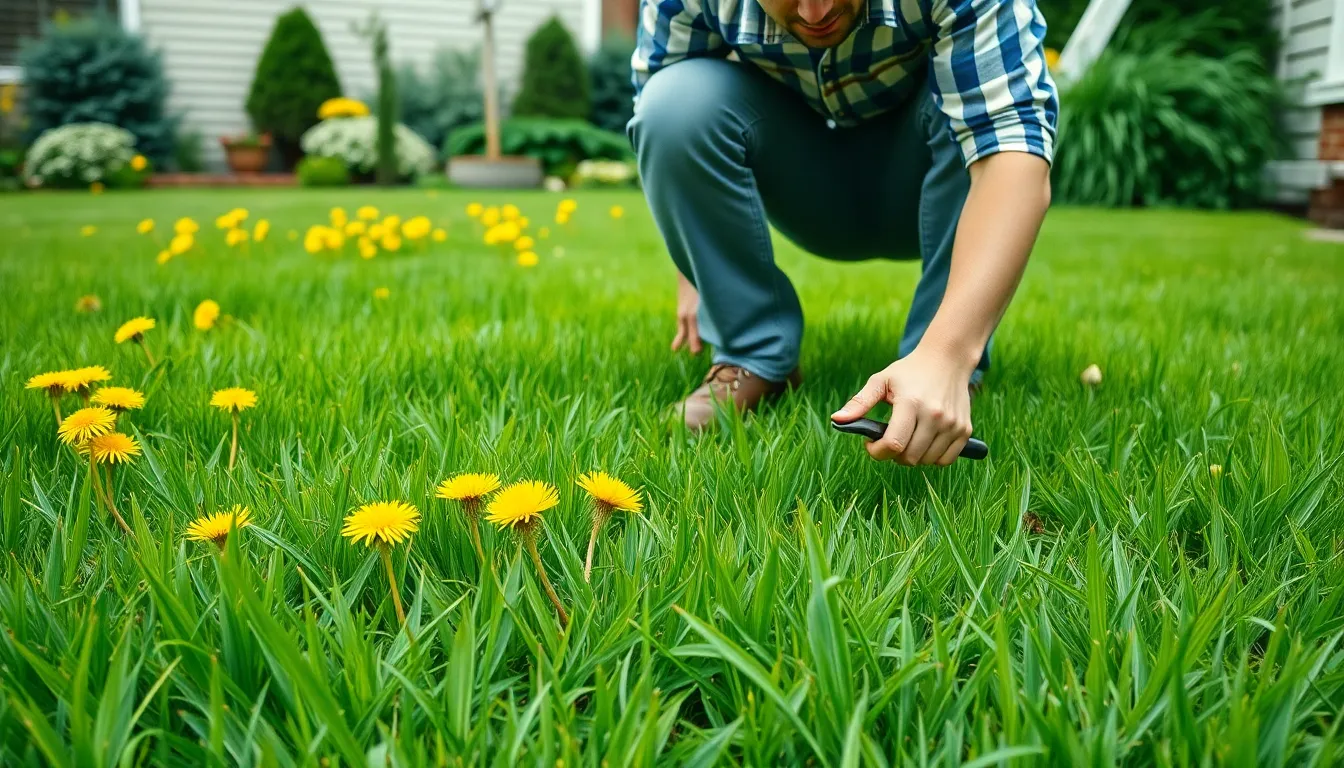
Preventing yellow flowered weeds from establishing in our gardens requires consistent maintenance practices that strengthen desired plants while creating unfavorable conditions for weed growth.
Lawn Maintenance Best Practices
Maintaining proper mowing height creates the foundation for preventing yellow flowered weeds like dandelions and creeping buttercup from establishing in our lawns. Grass cut at the ideal height for each species develops dense root systems that crowd out weed seeds attempting to germinate.
Regular monitoring allows us to identify and remove yellow flowered weeds before they establish extensive root systems or produce seeds. Weekly inspections during peak growing seasons help us catch small infestations of black medic and St. John’s Wort before they spread throughout the lawn.
Dense grass coverage prevents yellow flowered weeds from accessing the sunlight necessary for photosynthesis. Overseeding thin areas eliminates the open spaces where creeping buttercup and yellow sweet clover typically establish their initial footholds.
Soil Health and Fertilization
Balanced fertilization strengthens grass and desired plants against competition from yellow flowered weeds by providing optimal nutrient ratios for healthy growth. Lawns receiving proper nitrogen levels develop thick canopies that shade out dandelion seedlings and other yellow flowered invaders.
Soil testing reveals nutrient deficiencies that weaken our desired plants and create opportunities for yellow flowered weeds to establish. Annual soil tests guide our fertilization programs to address exact imbalances that favor weed growth over healthy grass development.
Organic matter incorporation improves soil structure and water retention while supporting beneficial microorganisms that compete with weed seeds for resources. Compost applications create soil conditions that favor established plants over opportunistic yellow flowered weeds.
Proper Watering Techniques
Judicious watering practices prevent the wet conditions that encourage creeping buttercup and other moisture loving yellow flowered weeds from thriving in our landscapes. Deep infrequent watering promotes strong root development in desired plants while avoiding the shallow moisture that favors weed seed germination.
Even water distribution across our lawns eliminates the standing water and soggy areas where creeping buttercup establishes colonies. Proper irrigation timing during early morning hours allows grass to absorb moisture efficiently while reducing the extended wet periods that yellow flowered weeds exploit.
Drought stress management through consistent watering schedules keeps our grass competitive against yellow flowered weeds that often establish during periods when desired plants struggle with water limitations.
Troubleshooting Common Yellow Weed Problems
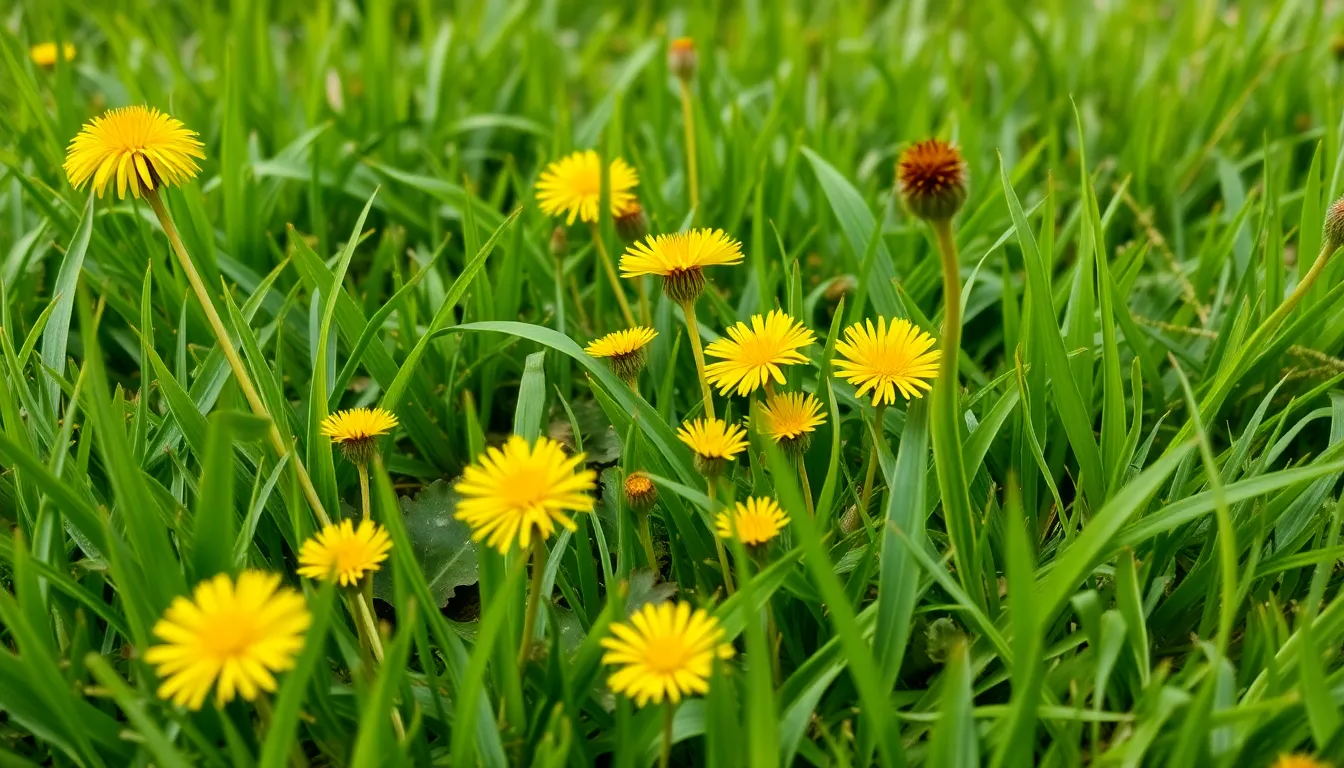
Proper identification remains crucial for effective control when yellow-flowered weeds persist even though our initial efforts. Many yellow-flowered weeds resemble desired plants like dandelions being mistaken for daisies, making accurate identification the foundation of successful management.
When Weeds Keep Coming Back
Recurring weeds indicate incomplete root removal or favorable growing conditions that support regrowth. Dandelions and other deep-rooted species regenerate from root fragments left in the soil after surface removal attempts.
Monitor your lawn regularly for signs of regrowth and apply control measures within 2-3 weeks of initial emergence. Consistent surveillance prevents small patches from developing into established colonies that compete more aggressively with desired plants.
Maintain healthy grass coverage to create natural competition against yellow-flowered invaders. Dense turf prevents weed seeds from reaching soil and germinating by blocking sunlight access to the ground level.
Apply mulch around garden beds and industry areas to suppress new germinations. Organic mulch creates a 3-4 inch barrier that blocks light while retaining soil moisture for beneficial plants.
Address underlying soil conditions that favor weed establishment over desired vegetation. Poor drainage, compacted soil, or nutrient imbalances often create environments where weeds like creeping cinquefoil and common purslane thrive while grass struggles.
Dealing With Large Infestations
Broad-spectrum herbicides become necessary when yellow-flowered weeds cover extensive areas beyond practical hand-removal limits. These products control multiple weed species simultaneously but require careful application to avoid harming desirable plants nearby.
Target application timing during active growth periods when weeds actively transport herbicides to their root systems. Spring emergence and early summer growth stages provide optimal absorption windows for maximum effectiveness.
Pre-emergent herbicides prevent new germinations from expanding existing infestations during peak seeding periods. Apply these treatments 2-4 weeks before expected germination windows based on local growing conditions.
Divide large infested areas into manageable sections for systematic treatment approaches. Focus initial efforts on perimeter zones to prevent further spread while gradually working toward heavily infested center areas.
Combine multiple control methods for comprehensive management of widespread populations. Physical removal of mature plants reduces immediate seed production while herbicide applications target remaining root systems and emerging seedlings.
Addressing Herbicide-Resistant Varieties
Enhanced cultural practices mitigate resistance development when standard herbicide applications lose effectiveness against persistent yellow-flowered species. Diverse control methods prevent weeds from adapting to single treatment approaches.
Rotate between different herbicide modes of action every 2-3 growing seasons to maintain treatment effectiveness. Chemical rotation prevents target weeds from developing genetic resistance to exact active ingredients.
Integrate physical removal with chemical treatments to create comprehensive management programs that resistant varieties cannot easily overcome. Hand-pulling mature plants eliminates seed sources while herbicides control emerging populations.
Improve soil health through organic matter additions and proper pH management to strengthen competitive advantages of desired plants. Healthy soil ecosystems support beneficial plants that naturally suppress weed establishment and growth.
Carry out diverse management strategies including mulching, dense plantings, and regular maintenance schedules. Multiple pressure points create challenging environments for resistant weeds while supporting overall industry health and stability.
Alternative Uses for Yellow-Flowered Weeds
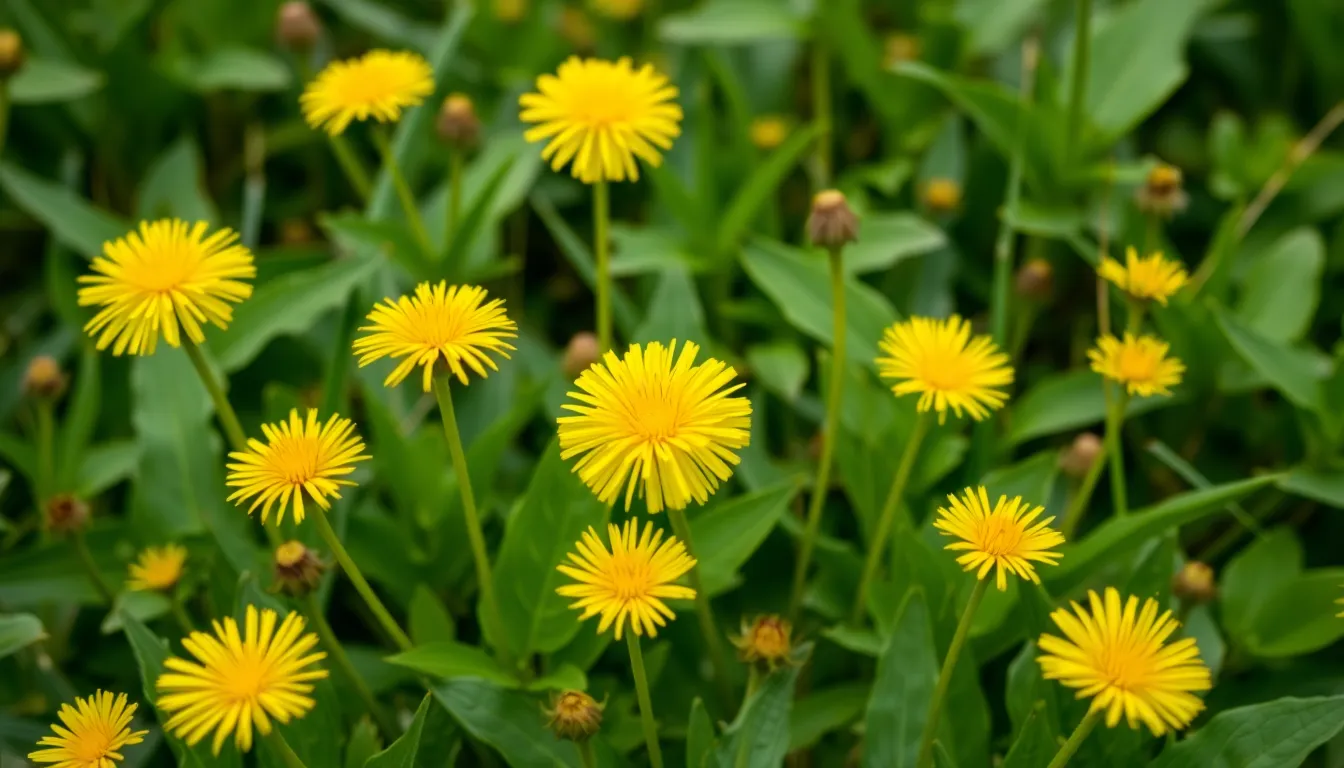
Yellow-flowered weeds offer valuable benefits beyond their reputation as garden nuisances. Many species provide ecological services and practical applications that gardeners can harness rather than eliminate.
Edible Weeds and Their Benefits
Dandelion (Taraxacum officinale) delivers exceptional nutritional value with leaves containing high levels of vitamins A, C, and K plus iron and calcium. Young dandelion leaves add bitter flavor to spring salads while older leaves work well sautéed or steamed. The flowers create colorful garnishes and can be battered and fried for unique appetizers.
Wild Mustard (Brassica spp.) provides peppery greens that enhance salads and stir-fries with their distinctive flavor profile. These plants grow rapidly in cool weather and offer tender leaves early in the growing season. Wild mustard seeds can be ground into homemade mustard condiments or used whole in pickling recipes.
Black Medic offers protein-rich seeds that indigenous peoples traditionally ground into flour. Cat’s-ear leaves taste similar to dandelion but with milder bitterness. Buttercup species require caution as most contain compounds that make them unsuitable for consumption.
Using Weeds for Composting
Comfrey accelerates decomposition in compost piles due to its deep taproot system that draws nutrients from lower soil layers. This yellow-flowered weed contains high levels of potassium and nitrogen that benefit compost chemistry. Comfrey leaves break down quickly and create nutrient-rich liquid fertilizer when steeped in water for 2-3 weeks.
Most yellow-flowered weeds contribute carbon and nitrogen to balanced compost systems when mixed with brown materials like dried leaves or cardboard. Dandelion roots and leaves decompose within 3-6 months in active compost piles. Wild mustard plants add sulfur compounds that benefit soil microorganisms during decomposition.
Avoid composting weeds with mature seeds unless your compost reaches temperatures above 140°F for several days. Remove flower heads before adding buttercup and black medic to prevent seed dispersal. Layer weed materials between browns at ratios of 1 part green weeds to 3 parts brown materials for optimal decomposition.
Conclusion
Managing yellow-flowered weeds doesn’t have to be an overwhelming task when we approach it with the right knowledge and tools. By understanding their growth patterns and identifying them accurately we can develop targeted strategies that work for our exact garden conditions.
The key to long-term success lies in combining multiple approaches – from natural removal methods and chemical treatments to preventive maintenance and soil health improvements. We’ve seen that consistency in our efforts makes the biggest difference in keeping these persistent invaders under control.
Remember that some yellow-flowered weeds offer unexpected benefits through edible uses and composting applications. With proper identification and management we can maintain beautiful gardens while working with nature’s resilience rather than against it.
Frequently Asked Questions
What are the most common yellow-flowered weeds in gardens?
The five most common yellow-flowered weeds are dandelions, buttercups, wild mustard, crabgrass, and plantain. Dandelions have deep taproots and spread through wind-blown seeds. Buttercups thrive in wet conditions and spread aggressively. Wild mustard grows rapidly and germinates early in spring. Crabgrass invades thin lawn areas, while plantain forms persistent broadleaf patches with deep root systems.
Why do yellow-flowered weeds grow so successfully in gardens?
Yellow-flowered weeds possess evolutionary advantages that help them outcompete cultivated plants. They have rapid seed production, attract pollinators effectively, and show excellent drought tolerance. Their deep taproot systems access water and nutrients from lower soil layers, while their dense growth patterns shade out other vegetation and colonize disturbed soils where garden plants struggle.
When do yellow-flowered weeds typically appear during the year?
Yellow-flowered weeds follow seasonal patterns, emerging in spring as temperatures warm. They reach peak bloom periods in late spring and early summer. Warm-season species dominate during summer months, while fall brings a resurgence of perennial species. Many survive winter through dormant seeds and active root systems, ensuring population continuity year-round.
What tools do I need to identify yellow-flowered weeds?
Essential identification tools include hand lenses for examining flower details, comprehensive field guides, and mobile apps like PlantSnap and iNaturalist. Take clear photographs from multiple angles showing flowers, leaves, and growth habits. Online databases and regional gardening communities provide additional resources. Comparative reference materials help confirm species matches for accurate identification.
How can I naturally remove yellow-flowered weeds without chemicals?
Hand-pulling works best when soil is moist, targeting the entire root system. Use specialized weed pullers for deep taproots. Natural herbicides include white vinegar, boiling water, and corn gluten meal as a pre-emergent treatment. Apply thick mulch layers to prevent regrowth and maintain consistent coverage to suppress new seedlings while conserving soil moisture.
When should I use chemical herbicides for yellow-flowered weeds?
Use herbicides when natural methods fail or for widespread infestations. Apply pre-emergent herbicides before seed germination and post-emergent types during active growth stages. Choose selective herbicides near desirable plants and broad-spectrum options for heavy infestations. Always follow label instructions, wear protective gear, and avoid application during windy conditions or near pollinators.
How can I prevent yellow-flowered weeds from returning?
Maintain healthy, dense grass coverage through proper mowing height and regular fertilization. Monitor regularly to catch new growth early. Improve soil health with balanced nutrition and proper watering techniques. Apply mulch in garden beds and overseed thin lawn areas. Consistent maintenance creates unfavorable conditions for weed establishment while strengthening desired plants.
Are yellow-flowered weeds useful for anything besides removal?
Many yellow-flowered weeds have practical uses. Dandelions and wild mustard are edible, offering nutritional value in salads and cooking. Some species like comfrey enhance compost piles by accelerating decomposition and adding nutrients. However, remove seed heads before composting to prevent spreading. These weeds also provide early nectar sources for pollinators when other flowers aren’t available.
What should I do if weeds persist despite my control efforts?
Persistent weeds may indicate herbicide resistance or incomplete identification. Rotate herbicide modes of action and combine physical removal with chemical treatments. Divide large infestations into manageable sections for systematic treatment. Improve soil health and maintain dense plant coverage to create natural competition. Consider professional consultation for stubborn or unknown species.
How do I safely handle yellow-flowered weed removal?
Always wear protective gloves and eye protection when handling weeds or chemicals. Some plants may cause skin irritation or allergic reactions. When using herbicides, follow all label instructions, wear appropriate clothing, and avoid application during windy conditions. Keep children and pets away from treated areas until products dry completely.

